
current / archive / issues / faq / RSS feed / twitter /
Blog Archive: August 2021
Double DoubleThis is the last proper full-length story that Doctor Doom stars in during 'The Marvel Age' (although there's still a few other ones to come), so it's fitting that it's almost a Greatest Hits, with various strands of continuity being referred to, notably a massive callback to the absolute classic 'Though Some Call It Magic' from way back in Astonishing Tales #8. It's nowhere near as good as that comic, but it's nice to be reminded of it at least!
The story picks up right from the end of Fantasic Four #305 with Doom demanding that the FF lend him Franklin for a bit. Doom has clearly been doing his homework, taking us through some of Franklin's recent adventures in 'Power Pack' and elsewhere, but Reed Richards is not going to let him borrow his son for anything.
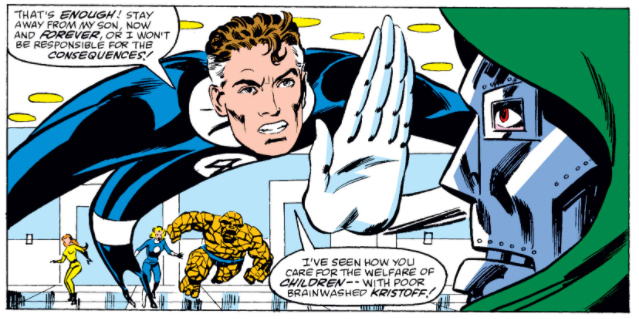 It's all very well Reed saying "I've seen how you care for the welfare of children - with poor, brainwashed Kristoff", but as far as I can see the FF haven't been looking after him much better - they've basically kept him locked up in a padded cell for two years without a change of clothes. Doom isn't bothered by this accusation, stating that Kristoff was activated "in error" and is now superfluous, which also seems a bit odd. We were led to believe that Doom cared for Kristoff, although the whole "mind wiping" plan does make me doubt that, but still it seems like a lot of effort to go through just to dump him when he's "activated" too early. Does he have other children lined up for future contingency plans?
It's all very well Reed saying "I've seen how you care for the welfare of children - with poor, brainwashed Kristoff", but as far as I can see the FF haven't been looking after him much better - they've basically kept him locked up in a padded cell for two years without a change of clothes. Doom isn't bothered by this accusation, stating that Kristoff was activated "in error" and is now superfluous, which also seems a bit odd. We were led to believe that Doom cared for Kristoff, although the whole "mind wiping" plan does make me doubt that, but still it seems like a lot of effort to go through just to dump him when he's "activated" too early. Does he have other children lined up for future contingency plans?
Doom tries to persuade them of his good intentions by swearing an oath that he will sacrifice himself before he allows Franklin to come to any harm.
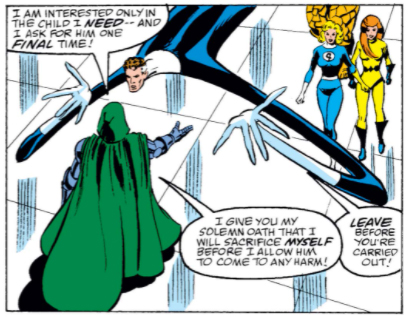 Unsurprisingly this cuts no ice, so he turns on his heals and heads back to the Embassy. Just when it seems that the rest of the annual is going to be the FF sitting around having a nice chat (as so many comics seem to be during this period) Doom attacks the Baxter Build... sorry, Four Freedoms Plaza, and a very long fight breaks out between the FF and Doom's devices. The FF win, but amongst the wreckage we see the true point of Doom's plan - there was a sneaky robot in there all along!
Unsurprisingly this cuts no ice, so he turns on his heals and heads back to the Embassy. Just when it seems that the rest of the annual is going to be the FF sitting around having a nice chat (as so many comics seem to be during this period) Doom attacks the Baxter Build... sorry, Four Freedoms Plaza, and a very long fight breaks out between the FF and Doom's devices. The FF win, but amongst the wreckage we see the true point of Doom's plan - there was a sneaky robot in there all along!
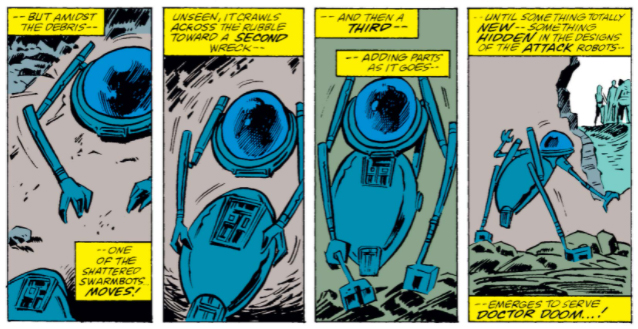 The robot snatches Franklin just as the FF are trying to launch into the previously mentioned chatting, and zooms off. Johnny gives chase and is so angry that he calls Doctor Doom the worst thing he can think of, not once but twice!
The robot snatches Franklin just as the FF are trying to launch into the previously mentioned chatting, and zooms off. Johnny gives chase and is so angry that he calls Doctor Doom the worst thing he can think of, not once but twice!
 "Pond scum!" Were the Comics Code Authority asleep on the job here? How did they allow such filth to get past them? The robot catches up with Doctor Doom in his aircraft, whereupon he tells Johnny that if Reed had lent him Franklin as asked he would have honoured his oath, but now he doesn't have to.
"Pond scum!" Were the Comics Code Authority asleep on the job here? How did they allow such filth to get past them? The robot catches up with Doctor Doom in his aircraft, whereupon he tells Johnny that if Reed had lent him Franklin as asked he would have honoured his oath, but now he doesn't have to.
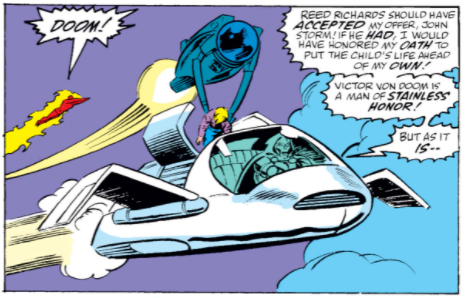 Sorry, what? He made the oath earlier without any conditions, we all saw him do it, so surely he can't just go back on it now? Part of the fun of Doom and his Solemn Oaths over the years has been seeing him get around them while still maintaining his self-image as a man of honour, but this is him just saying "Nah, not doing that now."
Sorry, what? He made the oath earlier without any conditions, we all saw him do it, so surely he can't just go back on it now? Part of the fun of Doom and his Solemn Oaths over the years has been seeing him get around them while still maintaining his self-image as a man of honour, but this is him just saying "Nah, not doing that now."
Doom then demonstrates some previously unseen child-handling skills, telling Franklin that his mother was "taken away from me by the bad man named Mephisto!" Doom calling somebody "bad man" doesn't feel right - he's not usually one to treat children like children - but it works and Franklin agrees to help, and off they go to Latveria.
Back at Four Freedoms Plaza the FF are indulging in some Claremont-esque bickering, furiously trying to blame each other for what's going on. Sue finds this as tiresome as I do, and tells them all to calm down and get ready for the flight to Latveria. As they set off we finally find out what's happened to Kristoff, as he uses a handy flute (?) to call the kidnapper robot back to his cell.
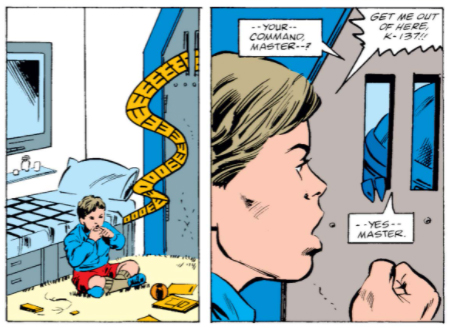 It's nice to see that Kristoff has actually had a change of clothes since last time, and his cell looks less padded, but it still has bars on the window and is very definitely a prison. What's nice about this scene though, and the use of Kristoff throughout the rest of the story, is that it massively leans into the idea that he thinks he's Doctor Doom. He doesn't act like a child pretending to be him or anything like that, he's pretty much a second copy, who knows all Doom's secrets and Cunning Plans. Well, technically he should only know Doom's secrets up to and including his first appearance in Fantastic Four #5
, as per his own origin story in Fantastic Four #278, but this is pretty much ignored for this entire story. It's a shame, as I quite like the idea of Real Doom fighting a version of himself from right at the very beginning of his super-villain career, but as we'll see the plot requires him to have a lot more knowledge than he should have.
It's nice to see that Kristoff has actually had a change of clothes since last time, and his cell looks less padded, but it still has bars on the window and is very definitely a prison. What's nice about this scene though, and the use of Kristoff throughout the rest of the story, is that it massively leans into the idea that he thinks he's Doctor Doom. He doesn't act like a child pretending to be him or anything like that, he's pretty much a second copy, who knows all Doom's secrets and Cunning Plans. Well, technically he should only know Doom's secrets up to and including his first appearance in Fantastic Four #5
, as per his own origin story in Fantastic Four #278, but this is pretty much ignored for this entire story. It's a shame, as I quite like the idea of Real Doom fighting a version of himself from right at the very beginning of his super-villain career, but as we'll see the plot requires him to have a lot more knowledge than he should have.
A prime of example of this is what happens next, as Kristoff flies all the way to Latveria on the robot's back and... hang on, what?
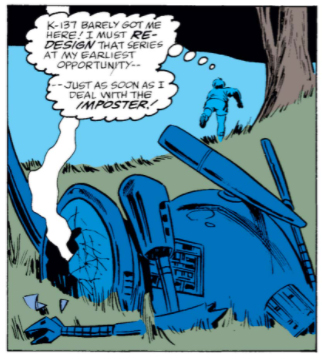 Kristoff arrives just after Doom and the FF, so must have flown at pretty high speeds, and while everyone else was safely encased in supersonic vehicles Kristoff was hanging onto a robot while wearing a pair of shorts. Before we can deal with anything there, he rushes off to a nearby barn on the edge of the country where he keeps a spare Doombot and Doctor Doom suit.
Kristoff arrives just after Doom and the FF, so must have flown at pretty high speeds, and while everyone else was safely encased in supersonic vehicles Kristoff was hanging onto a robot while wearing a pair of shorts. Before we can deal with anything there, he rushes off to a nearby barn on the edge of the country where he keeps a spare Doombot and Doctor Doom suit.
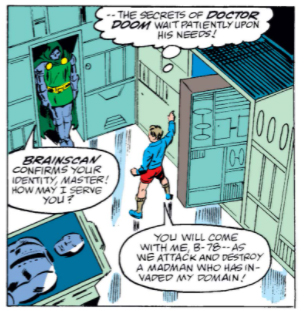 All right, how does this work? According to Kristoff's earlier appearance he was only Doom for a very short time, just long enough to abandon his mind-wipe and relaunch his attack on the Baxter Building. We know that this was all done in haste because the Doombots at the time said so, so when did he have time to set all this up? There's at least some attempt to embed this into the continuity, as the Doombot remarks upon his new "raiments" and Kristoff talks about how he must get the his robots similarly re-designed, but it doesn't actually help it make any sense!
All right, how does this work? According to Kristoff's earlier appearance he was only Doom for a very short time, just long enough to abandon his mind-wipe and relaunch his attack on the Baxter Building. We know that this was all done in haste because the Doombots at the time said so, so when did he have time to set all this up? There's at least some attempt to embed this into the continuity, as the Doombot remarks upon his new "raiments" and Kristoff talks about how he must get the his robots similarly re-designed, but it doesn't actually help it make any sense!
Once again we're not given time to ponder this as Kristoff and the Doombot hop into Latveria's apparently extensive tunnel system where they bump into the Fantastic Four, at which point Kristoff sets off a trap that he can't know about because... well, you get the general idea.
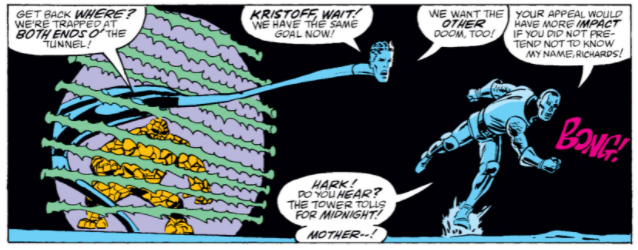 At this point we finally cut back to the real Doctor Doom, where it seems that Paul Neary has been doing some research, giving Boris the very same lamp he had in Astonishing Tales #8.
At this point we finally cut back to the real Doctor Doom, where it seems that Paul Neary has been doing some research, giving Boris the very same lamp he had in Astonishing Tales #8.
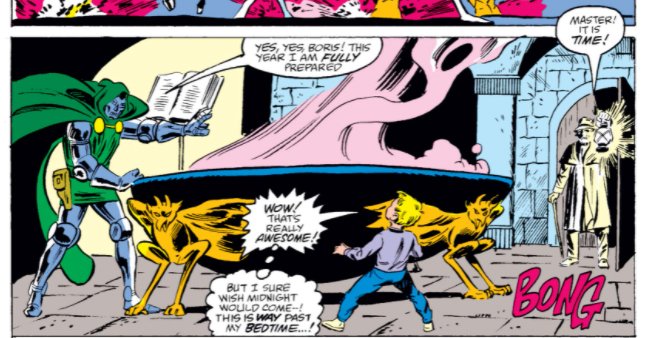
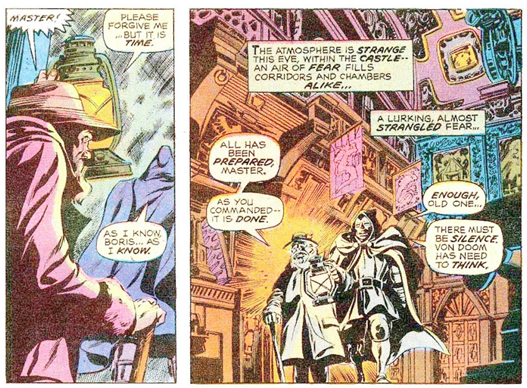 Clearly this lamp is now seen as a Signifier Of Boris, as we also saw him using it recently in
Clearly this lamp is now seen as a Signifier Of Boris, as we also saw him using it recently in  There's another call back to Astonishing Tales #8 too, as Doom recites a similar incantation, although this time he adds Mephisto's name in there to make it clear that's who he's after. As the demon's begin to appear Paul Neary also recalls Gene Colan's smoky demons.
There's another call back to Astonishing Tales #8 too, as Doom recites a similar incantation, although this time he adds Mephisto's name in there to make it clear that's who he's after. As the demon's begin to appear Paul Neary also recalls Gene Colan's smoky demons.
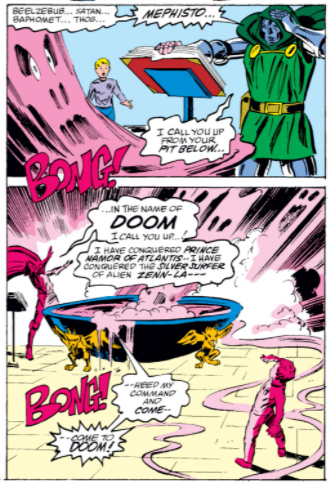
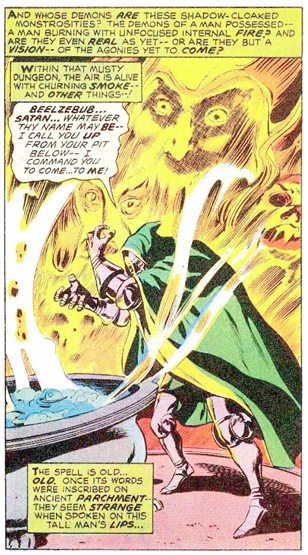 Doom calls out the names of Namor and The Silver Surfer as he does this, reminding us all of some of his past victories. I'm not sure Namor or the Surfer would remember it quite the same, but it's nice to get these reminders of former glories as we head towards the end of this run.
Doom calls out the names of Namor and The Silver Surfer as he does this, reminding us all of some of his past victories. I'm not sure Namor or the Surfer would remember it quite the same, but it's nice to get these reminders of former glories as we head towards the end of this run.
Mephisto turns up as requested, and Doom's evil plan is revealed: he's going to give Mephisto Franklin's soul in exchange for his mother's!
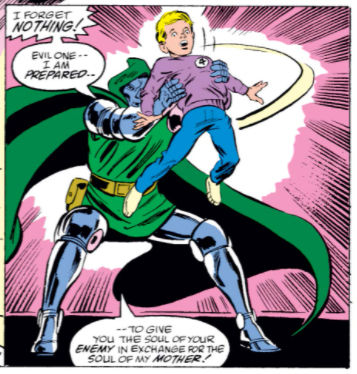 DAN-DAN-DAAAA!!! The FIEND! But hold on a minute, how does that work then? Can you just swap one soul for another? And if so, do you need to do it in person, or could Doom have just sent Mephisto a fax to make the offer? And what happened to the idea of people going willingly? If this is all that's required, couldn't Doom have done this ages ago?
DAN-DAN-DAAAA!!! The FIEND! But hold on a minute, how does that work then? Can you just swap one soul for another? And if so, do you need to do it in person, or could Doom have just sent Mephisto a fax to make the offer? And what happened to the idea of people going willingly? If this is all that's required, couldn't Doom have done this ages ago?
And also: what was the plan going to be if the FF HAD let him take Franklin with him, and he'd have been bound to keep his oath? Surely none of this would have worked then?
A theme of this comic seems to be that whenever Steve Englehart writes himself into a corner like this he throws in the sudden arrival of some Action, and that's exactly what he does next. Kristoff arrives with his army of Doombots, throwing everything into disarray. Mephisto is confused, and so are the Doombots!
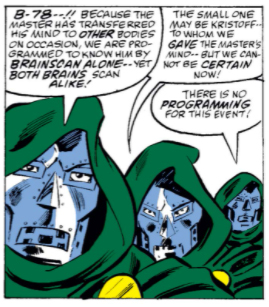 It looks to me as if Neary is quoting the Worried Doombots from Kristoff's first appearance, and I like the way that Englehart writes them the same way, like Civil Servants who are not quite sure that what their master is saying is quite correct, but feel professionally bound to go along with it.
It looks to me as if Neary is quoting the Worried Doombots from Kristoff's first appearance, and I like the way that Englehart writes them the same way, like Civil Servants who are not quite sure that what their master is saying is quite correct, but feel professionally bound to go along with it.
 Mephisto's had quite enough of all this and decides to go home to hell, taking Franklin with him. Again, this feels like cheating - is he allowed to just pop up to earth and steal any soul he fancies? I mean, I know he's Marvel's version of the Devil so should not be expected to play fairly, but if he can do that why doesn't he do it all the time? Why go to all the bother of Tempting or Tricking people if he can just take whoever he likes?
Mephisto's had quite enough of all this and decides to go home to hell, taking Franklin with him. Again, this feels like cheating - is he allowed to just pop up to earth and steal any soul he fancies? I mean, I know he's Marvel's version of the Devil so should not be expected to play fairly, but if he can do that why doesn't he do it all the time? Why go to all the bother of Tempting or Tricking people if he can just take whoever he likes?
Reed sees Mephisto disappearing, so quickly picks up a remote control for the Psychic Dampeners that Doom had set up on the castle (somehow) and follows Mephisto into hell through a wormhole, where he switches off the Dampeners. But surely those were only effective in Latveria weren't they? So why do they need to be switched off when they're in another dimension? Either way, Franklin's power is unleashed, Mephisto decides he can't be doing with this much hassle, and both Reed and Franklin get sent home again.
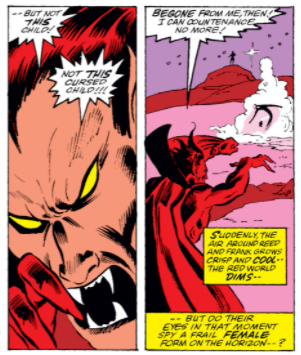 Once they get back Franklin's full powers are working again, and he decides he's going to punish Doom by sending him to hell. His dad tells him not to, as "no-one deserves to be sent to Mephisto", which I'm not sure I quite agree with. Doom has been an absolute swine here - I'd even go so far as to call him "Pond Scum"!
Once they get back Franklin's full powers are working again, and he decides he's going to punish Doom by sending him to hell. His dad tells him not to, as "no-one deserves to be sent to Mephisto", which I'm not sure I quite agree with. Doom has been an absolute swine here - I'd even go so far as to call him "Pond Scum"!
The final section of the comic is the aftermath, where we get Doom and Kristoff competing to be the most sad about "their" mother's death. At lot of this story has been nonsensical, but I do like the way that Englehart does this, with each of them getting annoyed at the other for being a fake version of themselves and blaming them for what's gone wrong. Reed Richards tells Real Doom that this was his fault all along, and Real Doom agrees.
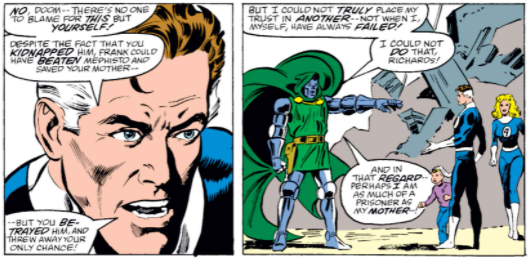 To me, this is a much needed return to Doom as Honourable Character, able to admit his own mistakes. We've not seen enough of that version in this issue, but it turns out that the Doombots prefer Straight Out Evil Doom, and decide that anyone prepared to admit weakness must be a fake.
To me, this is a much needed return to Doom as Honourable Character, able to admit his own mistakes. We've not seen enough of that version in this issue, but it turns out that the Doombots prefer Straight Out Evil Doom, and decide that anyone prepared to admit weakness must be a fake.
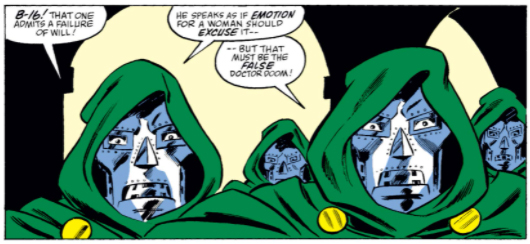 This is all a bit daft, but also brilliant! If we squint and cross our fingers we might even be able to see it as an acknowledgement of how much Doom has evolved as a character over the past 26 years, going from a straight-out villian (as portrayed by Kristoff) to a quasi-honourable human being who is at least partially self-aware. It's also a Really Cool Twist which allows Kristoff to take control of the situation, ordering the Doombots to attack and forcing Real Doom to display yet more of his characteristics by a) blowing up some robots and b) fleeing the scene while c) insisting he is definitely not fleeing the scene.
This is all a bit daft, but also brilliant! If we squint and cross our fingers we might even be able to see it as an acknowledgement of how much Doom has evolved as a character over the past 26 years, going from a straight-out villian (as portrayed by Kristoff) to a quasi-honourable human being who is at least partially self-aware. It's also a Really Cool Twist which allows Kristoff to take control of the situation, ordering the Doombots to attack and forcing Real Doom to display yet more of his characteristics by a) blowing up some robots and b) fleeing the scene while c) insisting he is definitely not fleeing the scene.
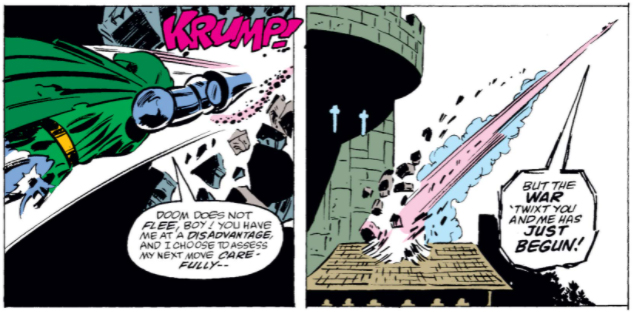 All that remains is for Reed to have one more go at persuading Kristoff he's not really Doom, by saying "I don't suppose it would do any good to tell you once more that you're not Doctor Doom?" If that's been his methodology all this time then it's not really surprising that Kristoff's had absolutely no progress for two years, and here he brushes this aside, so that the FF are left to simply wander off and go home in an ending that is either a subtle nod to "The Most Off-Beat Ending Of The Year" in Fantastic Four #87, or just Englehart and Neary getting to the last page all of a sudden.
All that remains is for Reed to have one more go at persuading Kristoff he's not really Doom, by saying "I don't suppose it would do any good to tell you once more that you're not Doctor Doom?" If that's been his methodology all this time then it's not really surprising that Kristoff's had absolutely no progress for two years, and here he brushes this aside, so that the FF are left to simply wander off and go home in an ending that is either a subtle nod to "The Most Off-Beat Ending Of The Year" in Fantastic Four #87, or just Englehart and Neary getting to the last page all of a sudden.
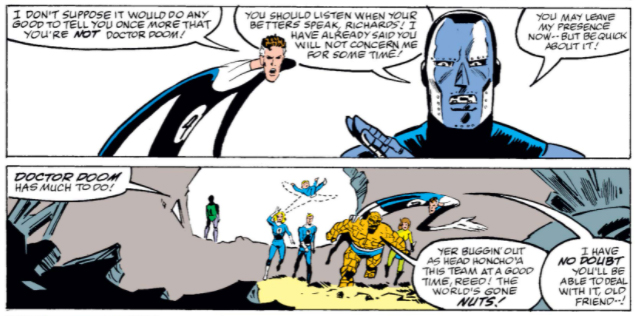 And that's the end of that! As I say, we're very close to the end of this selection of comics and other texts, with just a couple of cameo appearances to go before we have a bit of a tidy up with a few items that got missed along the way. It would have been nice to have another classic story to finish off with here, but in a way it's nice to have something like this instead, which leans heavily into continuity but is also filled with big fight scenes, nonsensical plots, and some Really Cool Bits. That sums up an awful lot of what we've been reading!
And that's the end of that! As I say, we're very close to the end of this selection of comics and other texts, with just a couple of cameo appearances to go before we have a bit of a tidy up with a few items that got missed along the way. It would have been nice to have another classic story to finish off with here, but in a way it's nice to have something like this instead, which leans heavily into continuity but is also filled with big fight scenes, nonsensical plots, and some Really Cool Bits. That sums up an awful lot of what we've been reading!
posted 27/8/2021 by MJ Hibbett
(click here for permanent link)
(0) comments
All In The Family!
We're getting very close to the end of 'The Marvel Age' now, and this issue feels like a good example of what Marvel comics were like at this point, with some nice-looking but fairly unexciting artwork, a LOT of continuity, and some 'adult themes' which are dealt with in a way that feels rather uncomfortable now.
The main thrust of the storyline is that The Thing has taken over the running of the Fantastic Four because Mr Fantastic and the Invisible Woman want to go off and spend more time with their son Franklin. The Human Torch (now married to Alicia) is still around, which means that Ben Grimm still has to find two extra members, and the issue is mostly about how he starts making those choices. This involves an awful lot of Talking and Thinking and characters not really doing much at all - the Thing spends the first two pages standing on a roof having a Good Old Think, and apart from a couple of brief sequences where Superheroes Fight Each Other, that's pretty much how it carries on.
Crystal, former team-member and ex of Johnny Storm, pops in to see her estranged husband Quicksilver, who the FF recently captured after he'd gone mad. He claims to have been driven mad by Crystal's marital infidelity, and there's some distinctly iffy scenes throughout the issue where other characters react to this as if they were in the 1950s, rather than the 1980s.
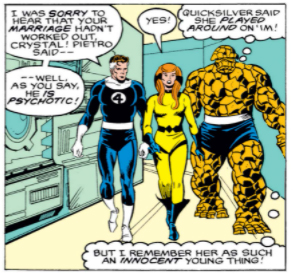 It reminds me of the scene back in Fantastic Four #237 where it's hinted that Ben and Alicia had sex whilst they were in their robot bodies in Liddleville, and Ben struggles to cope with this - not because he was human, or they were trapped in tiny robot bodies, but because they weren't married.
It reminds me of the scene back in Fantastic Four #237 where it's hinted that Ben and Alicia had sex whilst they were in their robot bodies in Liddleville, and Ben struggles to cope with this - not because he was human, or they were trapped in tiny robot bodies, but because they weren't married.
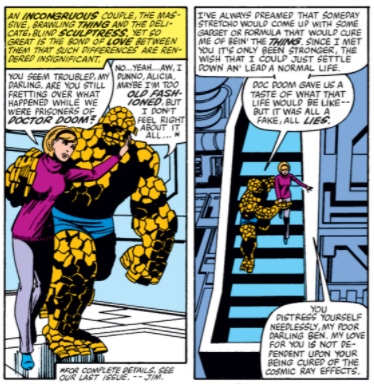 Talking of Alicia, Ben is still not happy about her being married to Johnny (we'll eventually find out that she's actually a Skrull pretending to be Alicia, but that's a way off yet), so when he asks Crystal to join the team the others all wander whether he's just doing it to drive a wedge between the newlyweds. The message seems to be that Crystal has already cheated in her own marriage, so won't be worried about intervening in someone else's.
Talking of Alicia, Ben is still not happy about her being married to Johnny (we'll eventually find out that she's actually a Skrull pretending to be Alicia, but that's a way off yet), so when he asks Crystal to join the team the others all wander whether he's just doing it to drive a wedge between the newlyweds. The message seems to be that Crystal has already cheated in her own marriage, so won't be worried about intervening in someone else's.
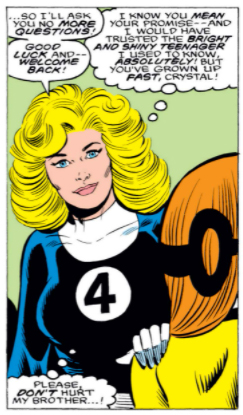 While all that's going on we get a brief glimpse into the padded holding cells where Quicksilver is being kept next door to Kristoff, who we last saw two years ago, back in Fantastic Four #279.
While all that's going on we get a brief glimpse into the padded holding cells where Quicksilver is being kept next door to Kristoff, who we last saw two years ago, back in Fantastic Four #279.
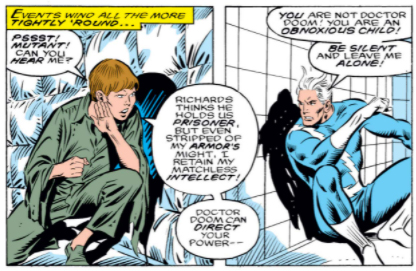 This leads to a couple of important questions. Firstly, if Kristoff has been under the care of the Fantastic Four for all that time, how come they've never given him a decent change of clothes? Secondly, Reed says that "The Courts have agreed to let us keep him temporarily while specialists come in to check him over constantly" but he looks very much like a prisoner to me, kept in a privately owned padded cell against his will with no visitors apparent at any point. Thirdly, and finally - the FF have a whole prison facility? Who else have they been keeping in there?!?
This leads to a couple of important questions. Firstly, if Kristoff has been under the care of the Fantastic Four for all that time, how come they've never given him a decent change of clothes? Secondly, Reed says that "The Courts have agreed to let us keep him temporarily while specialists come in to check him over constantly" but he looks very much like a prisoner to me, kept in a privately owned padded cell against his will with no visitors apparent at any point. Thirdly, and finally - the FF have a whole prison facility? Who else have they been keeping in there?!?
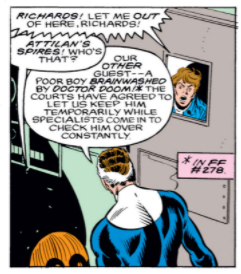 The politics of all of this are deeply conservative, and so is the artwork by Marvel legends John Buscema and Joe Sinnott. It all looks perfectly nice, even when Steve Englehart doesn't really give them much to illustrate apart from people having conversations, but it feels curiously out of place in a comic from 1987, just on the cusp of the 90's stylings of Rob Liefeld, Art Adams, Todd McFarlane and the like.
The politics of all of this are deeply conservative, and so is the artwork by Marvel legends John Buscema and Joe Sinnott. It all looks perfectly nice, even when Steve Englehart doesn't really give them much to illustrate apart from people having conversations, but it feels curiously out of place in a comic from 1987, just on the cusp of the 90's stylings of Rob Liefeld, Art Adams, Todd McFarlane and the like.
Throughout the story we've had an occasional narration from a Mysterious Voice who seems to be watching them all, plotting something. This is very Doom-like behaviour, as is Appearing Dramatically on the very last page, which is exactly what he does!
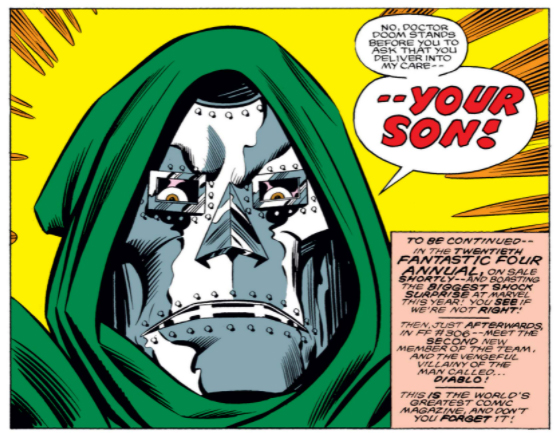 With all of the mentions of Kristoff we might expect that Doom has come to collect him, but no, "I care nothing for Kristoff", he says, he's there to collect Franklin instead. What can this mean? What is his big plan? We'll have to wait until next time to find out, in "Fantastic Four Annual" #20!
With all of the mentions of Kristoff we might expect that Doom has come to collect him, but no, "I care nothing for Kristoff", he says, he's there to collect Franklin instead. What can this mean? What is his big plan? We'll have to wait until next time to find out, in "Fantastic Four Annual" #20!
posted 20/8/2021 by MJ Hibbett
(click here for permanent link)
(0) comments
Free
We're getting really close to the end of this project now, with only a few texts left to go in the official list and then a couple of "addenda" where I've discovered other items along the way that should have featured much earlier. After that I'm hoping to do a couple of overviews, looking at how Doom works and what sort of thing keeps cropping up, such as a particular aspect of Doom's history that keeps getting referred to again and again, including in this issue i.e. that time he stole the Silver Surfer's power cosmic.
This has cropped up on several occasions, notably in Silver Surfer #1 in 1968, Silver Surfer #1 in 1982, and here again in Silver Surfer #1 in 1987. The fact that Doom keeps popping up whenever the Silver Surfer has a first issue does lead me to think that it's also an important event in the latter's life as well!
The original storyline took place over four issues, in the classic "The Peril And The Power" running from Fantastic Four #57 to Fantastic Four #60 (not 58-60 as it says in the editorial box below), but here the whole story is retold in just three panels, as part of a brief history of The Silver Surfer which takes about three pages all together to give us his whole story so far, including a panel for the aforementioned Silver Surfer #1 of 1982.
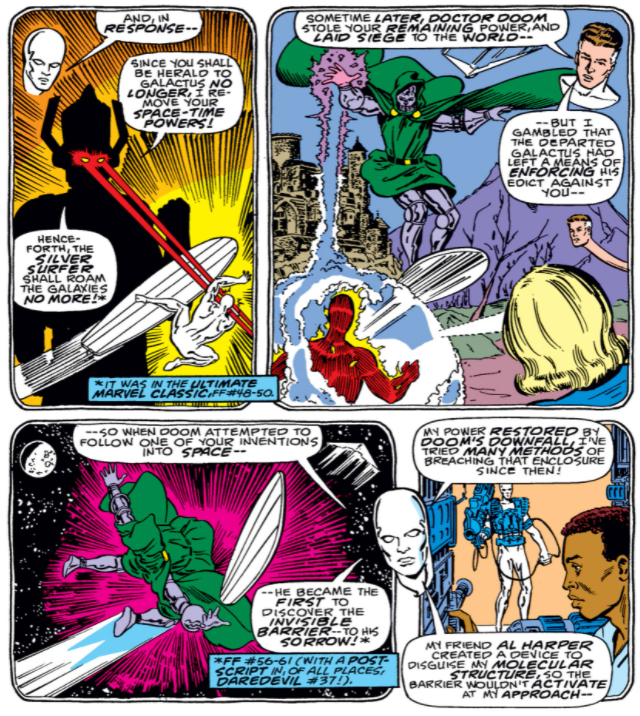 Doom doesn't appear in the rest of the story, which sees the Fantastic Four helping the Surfer to escape the Earth, after which he goes to visit Galactus to ask him not to put him behind another barrier (personally I'd have just kept quiet, rather than alerting him to the fact that I'd got out). Galactus sets him a quest to rescue his current herald, which the Surfer does fairly easily, and with his mind set at rest he then zooms off for cosmic adventures in the rest of the series. It's all perfectly pleasant, and extremely glossy - much like the Akin & Garvey poster last time, but here with Marhsall Rogers inked by the veteran Joe Rubinstein, who appears to be trying (and succeeding) to keep up with the current shiny style.
Doom doesn't appear in the rest of the story, which sees the Fantastic Four helping the Surfer to escape the Earth, after which he goes to visit Galactus to ask him not to put him behind another barrier (personally I'd have just kept quiet, rather than alerting him to the fact that I'd got out). Galactus sets him a quest to rescue his current herald, which the Surfer does fairly easily, and with his mind set at rest he then zooms off for cosmic adventures in the rest of the series. It's all perfectly pleasant, and extremely glossy - much like the Akin & Garvey poster last time, but here with Marhsall Rogers inked by the veteran Joe Rubinstein, who appears to be trying (and succeeding) to keep up with the current shiny style.
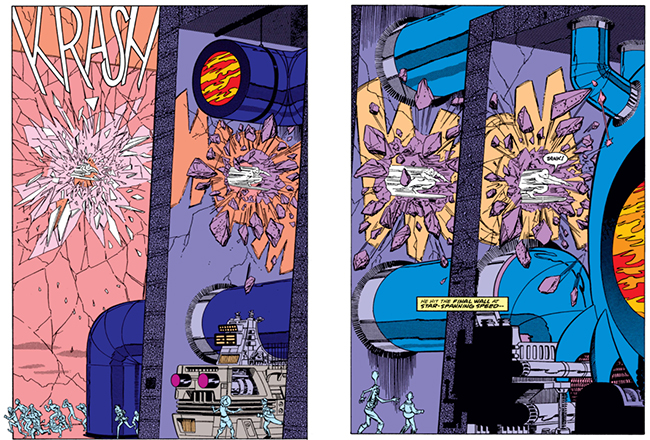 Other than that the only oddity is that the Fantastic Four line-up is Mr Fantastic, Invisible Woman, The Thing and She-Hulk, which is not a combination I was ever aware of existing, although we're now just past the Byrne run of the series, which is when I stopped buying it. Steve Englehart was writing the FF then, as he was this series, so I guess he'd know what the line-up was - we'll find out next time when we look at an issue of his run on "The Fantastic Four", featuring a whole lot of Adult Issues and another classic Doom trope: popping up at the very end for the cliffhanger. See you then!
Other than that the only oddity is that the Fantastic Four line-up is Mr Fantastic, Invisible Woman, The Thing and She-Hulk, which is not a combination I was ever aware of existing, although we're now just past the Byrne run of the series, which is when I stopped buying it. Steve Englehart was writing the FF then, as he was this series, so I guess he'd know what the line-up was - we'll find out next time when we look at an issue of his run on "The Fantastic Four", featuring a whole lot of Adult Issues and another classic Doom trope: popping up at the very end for the cliffhanger. See you then!
posted 13/8/2021 by MJ Hibbett
(click here for permanent link)
(0) comments
Akin and Garvey Portfolio
As discussed before, "Marvel Fanfare" was a slightly odd series which never seemed to know what it was meant to be. In theory it was meant to be a showcase for the very best creators, but in practice it was more often a dumping ground for inventory material. Usually Al Milgrom, the editor, went to great pains to deny this, but here he has no choice but to admit it.
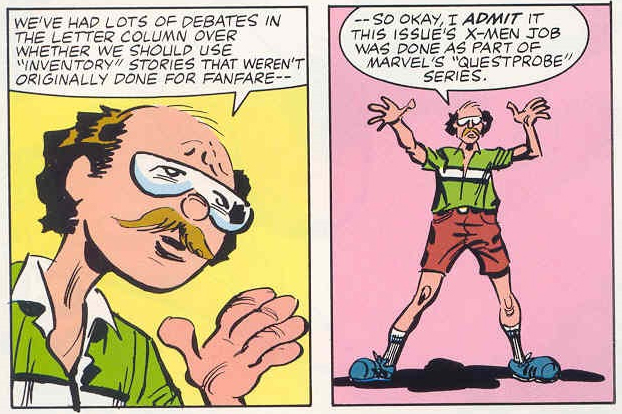 He goes on to say that the lead story is still justified for Marvel Fanfare because it features "Claremont, Brigman and Austin", but while it does look very nice it can't be ignored that it was originally created as a tie-in for an X-Men "Questprobe" game that never happened. It even features The Chief Examiner, who we met way back in Questprobe Featuring The Human Torch And The Thing. This story ties into all of the previous games and, by trying to explain what it all means, makes about as much sense as they did i.e. not an awful lot.
He goes on to say that the lead story is still justified for Marvel Fanfare because it features "Claremont, Brigman and Austin", but while it does look very nice it can't be ignored that it was originally created as a tie-in for an X-Men "Questprobe" game that never happened. It even features The Chief Examiner, who we met way back in Questprobe Featuring The Human Torch And The Thing. This story ties into all of the previous games and, by trying to explain what it all means, makes about as much sense as they did i.e. not an awful lot.
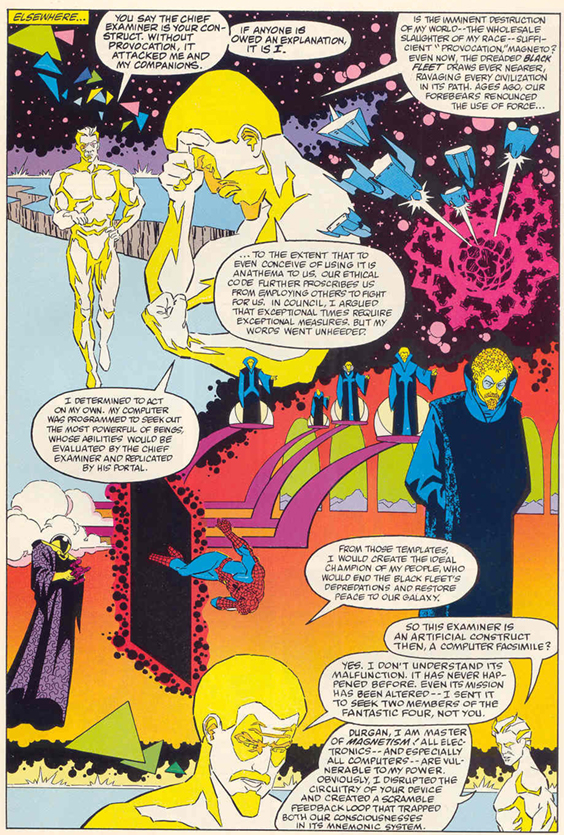 Doctor Doom doesn't appear in this story at all - in all the other issues of "Marvel Fanfare" we've looked at he's popped up either in very small cameos or as part of the "portfolios" section, and here he has a full page poster in one of the latter. It's drawn by Akin & Garvey, an inking duo working for Marvel around this time who were known for their smooth, super glossy inks on stories like "Rom" and "Transformers". I remember really liking them at the time, as they were very much in the same league as Bob Layton, taking anybody's pencils and placing them firmly in their own style. The picture of Doom included in the posters is very recognisably by them, even with nobody else underneath them.
Doctor Doom doesn't appear in this story at all - in all the other issues of "Marvel Fanfare" we've looked at he's popped up either in very small cameos or as part of the "portfolios" section, and here he has a full page poster in one of the latter. It's drawn by Akin & Garvey, an inking duo working for Marvel around this time who were known for their smooth, super glossy inks on stories like "Rom" and "Transformers". I remember really liking them at the time, as they were very much in the same league as Bob Layton, taking anybody's pencils and placing them firmly in their own style. The picture of Doom included in the posters is very recognisably by them, even with nobody else underneath them.
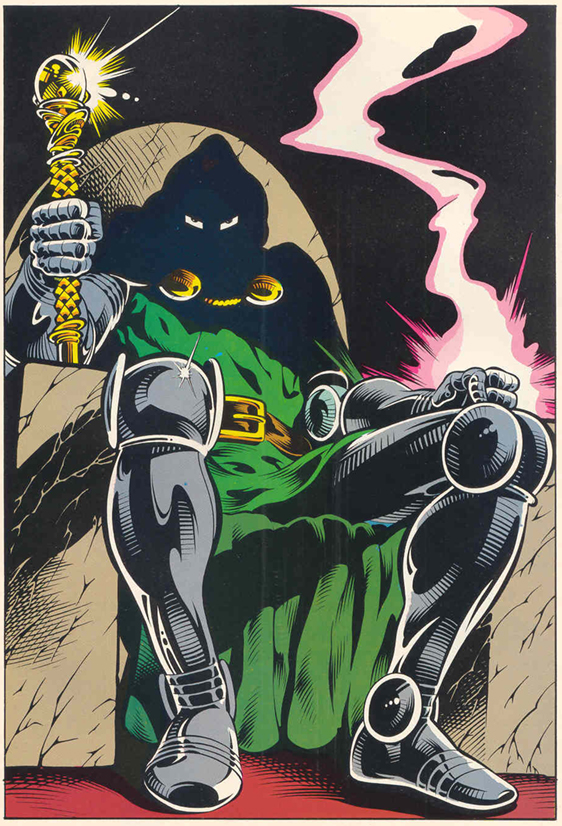 I'm not sure where that sceptre comes from, but otherwise this is a pretty standard depiction of Doom sitting on a throne, glowering away, with most of his standard signifiers showing. We can't see his nose or any rivets in his shadowed face, but this does at least draw attention to his very visible eyes through the mask!
I'm not sure where that sceptre comes from, but otherwise this is a pretty standard depiction of Doom sitting on a throne, glowering away, with most of his standard signifiers showing. We can't see his nose or any rivets in his shadowed face, but this does at least draw attention to his very visible eyes through the mask!
That's it for this time, but come back later in the week for yet another cameo, in yet another first issue of "The Silver Surfer"!
posted 11/8/2021 by MJ Hibbett
(click here for permanent link)
(0) comments
A Matter Of Faith
What's going on with the covers for this series? I wonder if Jon Bogdanov drew them all before reading any of the scripts, expecting all sorts of action and excitement and getting... well, lots and lots of talking. As with last time, it looks great but nothing even approaching this scene happens in the comic itself!
We do get some quite interesting additions to Doctor Doom's history, but before that we have to wade through an awful lot of Claremont's trademark dialogue, which I must admit does become annoying after a while. Actually, it's pretty annoying to start with, as we start with Kitty changing the lyrics to "I am sixteen going on seventeen" in her head but changing the words, and then - in her internal monologue - offering a formal apology to the writer.
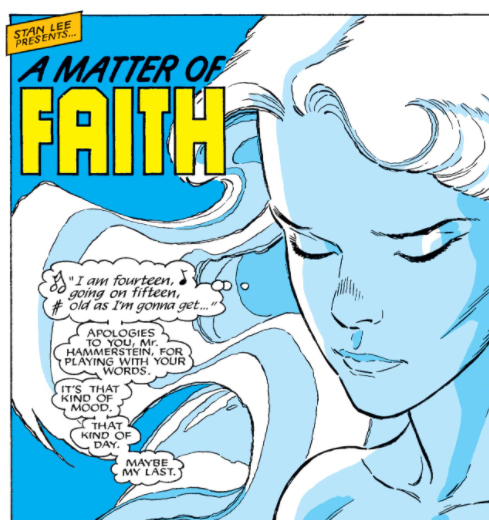 There's several more pages of extremely verbose inner dialoguing, as Franklin appears to comfort Kityy, and then even more dialogue between the FF as they fly to Latveria. As I said last time, it doesn't half go on!
There's several more pages of extremely verbose inner dialoguing, as Franklin appears to comfort Kityy, and then even more dialogue between the FF as they fly to Latveria. As I said last time, it doesn't half go on!
However, all this talking does give us a bit of previously unheard information about Doctor Doom's back-story. She-Hulk apparently spent some time at Empire State University (the fictional University where most Marvel characters go) and spoke to some old lecturers of Reed and Doom. According to them Reed and Doom were highly competitive, constantly arguing with each other about all manner of topics as they stomped around the campus together.
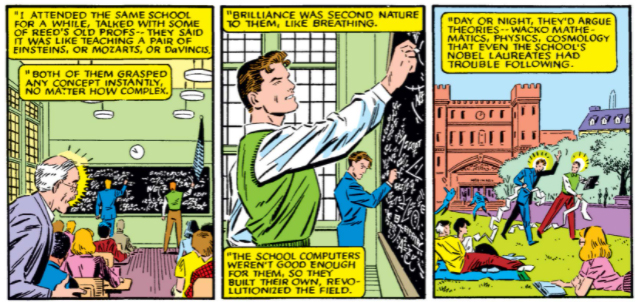 This sounds entirely reasonable, and fits what we know so well that at first I didn't notice that it isn't actually something that had been mentioned before. The story of Doom and Reed being rivals has often been told, but this little detail hasn't, and it easily explains why, for instance, Reed would have been doing looking through Doom's equations. It also leads to yet another quotation of the famous image from his origin story in Fantastic Four Annual #2 that's been seen so many times before.
This sounds entirely reasonable, and fits what we know so well that at first I didn't notice that it isn't actually something that had been mentioned before. The story of Doom and Reed being rivals has often been told, but this little detail hasn't, and it easily explains why, for instance, Reed would have been doing looking through Doom's equations. It also leads to yet another quotation of the famous image from his origin story in Fantastic Four Annual #2 that's been seen so many times before.
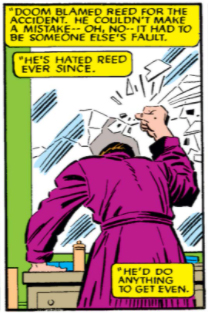
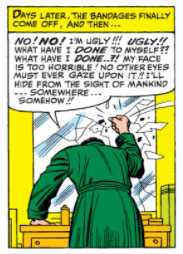 It's worth restating at this point that the art throughout is fantastic. Jon Bogdanov is very good at facial expressions, drawing a great Franklin (even when he's being written at his most mawkish) who actually looks like a child for once, and a charming panel where Dazzler delights in beating Havok during "training" in the forest.
It's worth restating at this point that the art throughout is fantastic. Jon Bogdanov is very good at facial expressions, drawing a great Franklin (even when he's being written at his most mawkish) who actually looks like a child for once, and a charming panel where Dazzler delights in beating Havok during "training" in the forest.
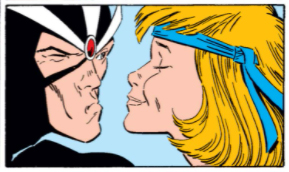 The "training" session (training for some advance bickering and fighting, perhaps) happens while everyone's hanging around waiting for Doom to finally get started with his cure for Kitty. However, when this does eventually get started it's almost immediately put in jeopardy by Magneto, melting Doom's robots with his magnetic powers and thus interfering with Doom's computers.
The "training" session (training for some advance bickering and fighting, perhaps) happens while everyone's hanging around waiting for Doom to finally get started with his cure for Kitty. However, when this does eventually get started it's almost immediately put in jeopardy by Magneto, melting Doom's robots with his magnetic powers and thus interfering with Doom's computers.
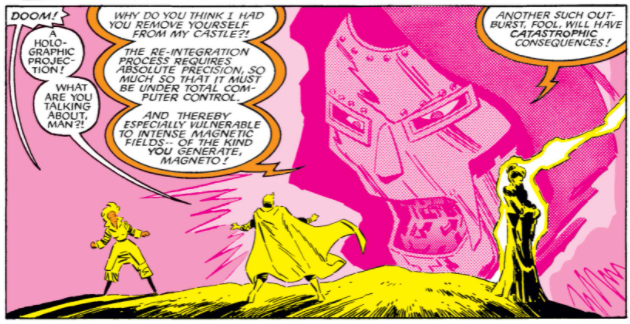 This is an absolutely classic bit of Doom action, with him looming out of the sky as he has done so many times before. The other characters might be annoying and stupid, but Claremont and Bogdanov are giving us a great Doctor Doom!
This is an absolutely classic bit of Doom action, with him looming out of the sky as he has done so many times before. The other characters might be annoying and stupid, but Claremont and Bogdanov are giving us a great Doctor Doom!
A prime example of this stupidity appears on the very next page. The Fantastic Four arrive and Magneto decides - despite being explicitly told, only a few seconds ago, that using his magnetic powers could kill Kitty - that the best thing to do is to use his magnetic powers to bring down the FF's plane. Storm is rightly livid with him, as is Doom.
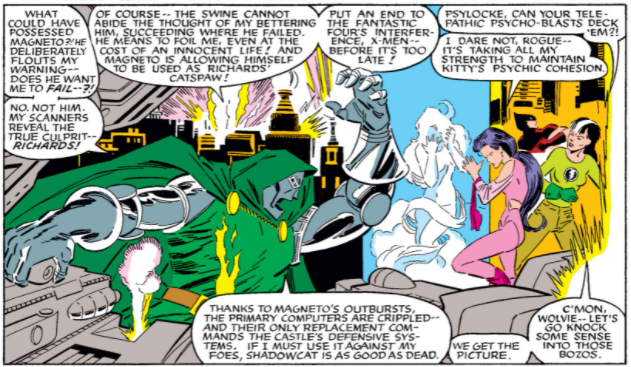 He sends the X-Men off to stop the Fantastic Four getting any closer, which they (stupidly) do. This leads to an extremely long and pointless fight which appears to be there to fulfill two functions: to fill in some space, and to get Rogue to steal the Human Torch's power and accidentally burn all her clothes off, like a superhero version of Jane.
He sends the X-Men off to stop the Fantastic Four getting any closer, which they (stupidly) do. This leads to an extremely long and pointless fight which appears to be there to fulfill two functions: to fill in some space, and to get Rogue to steal the Human Torch's power and accidentally burn all her clothes off, like a superhero version of Jane.
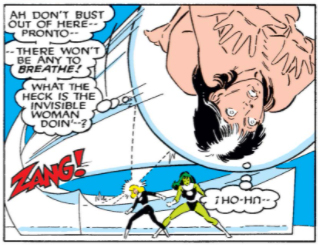 This goes on for ages until Franklin turns up and tells them to stop being such a bunch of idiots, and they all stomp off back to the castle where Doom is considering his next move. He's formulated an extremely cunning plan which result in either him saving Kitty and looking great, or getting to put the blame on the FF if it doesn't work.
This goes on for ages until Franklin turns up and tells them to stop being such a bunch of idiots, and they all stomp off back to the castle where Doom is considering his next move. He's formulated an extremely cunning plan which result in either him saving Kitty and looking great, or getting to put the blame on the FF if it doesn't work.
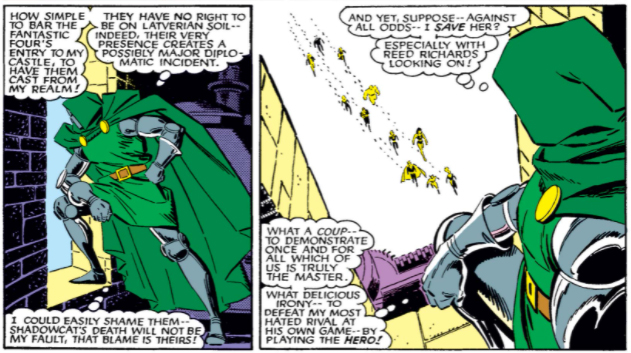 Better yet, he's spotted that Reed is still carrying that fake journal around - a journal which Doom recognises. It was him all along!
Better yet, he's spotted that Reed is still carrying that fake journal around - a journal which Doom recognises. It was him all along!
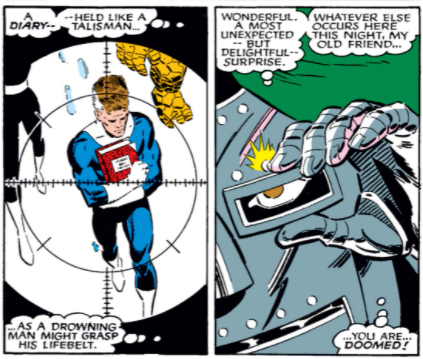 Everyone gathers around as Doom starts the process of curing Kitty, only for Reed to notice an error in Doom's calculations. As The Thing says, "Remember the first time Reed gave you a warning, back in college? Didn't you learn your lesson then?" While this is entirely true it's not exactly tactful, especially when Doom blames Reed for the entire incident Ben's referring to, so in the end it takes The Wisdom Of A Child to calm everybody down and work together.
Everyone gathers around as Doom starts the process of curing Kitty, only for Reed to notice an error in Doom's calculations. As The Thing says, "Remember the first time Reed gave you a warning, back in college? Didn't you learn your lesson then?" While this is entirely true it's not exactly tactful, especially when Doom blames Reed for the entire incident Ben's referring to, so in the end it takes The Wisdom Of A Child to calm everybody down and work together.
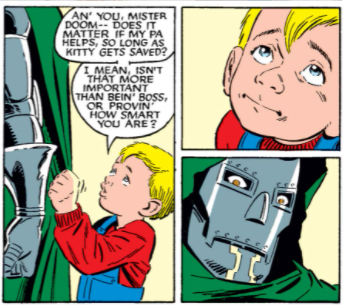 Doom and Reed start the process and all is well, until Reed is suddenly struck by Doubt. Maybe he did write that diary after all, he thinks, despite the fact that he has no memory of doing so. Doom suggests he get Psylocke to open his mind and find out, but this - well, basically, it's three pages of torturous self-examination as Reed grapples with his "inner demons" when actually he should be getting on with it and saving Kitty. It's intensely annoying, especially as Reed is eventually cured by Sue and Franklin Having Faith In Him and his own self-belief.
Doom and Reed start the process and all is well, until Reed is suddenly struck by Doubt. Maybe he did write that diary after all, he thinks, despite the fact that he has no memory of doing so. Doom suggests he get Psylocke to open his mind and find out, but this - well, basically, it's three pages of torturous self-examination as Reed grapples with his "inner demons" when actually he should be getting on with it and saving Kitty. It's intensely annoying, especially as Reed is eventually cured by Sue and Franklin Having Faith In Him and his own self-belief.
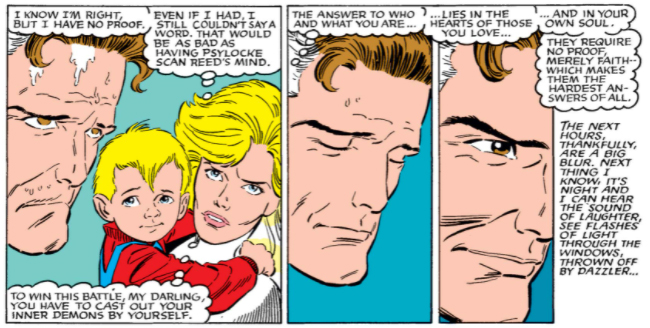 That was a whole lot of drama leading up to someone just going "Nah, it's fine."
That was a whole lot of drama leading up to someone just going "Nah, it's fine."
The rest of the issue is a great long slab of everybody sitting around chatting again. The highlight is Sue telling Doom that she knows he forged the diary deliberately (years ago, I guess, as a long-term Scheme?), to which Doom responds by going on about caviar. Not only is this some pretty excellent Doom characterisation, but it also gives us another solution for the age old "How does Doom eat?" question - his mouth grill appears to be retractable!
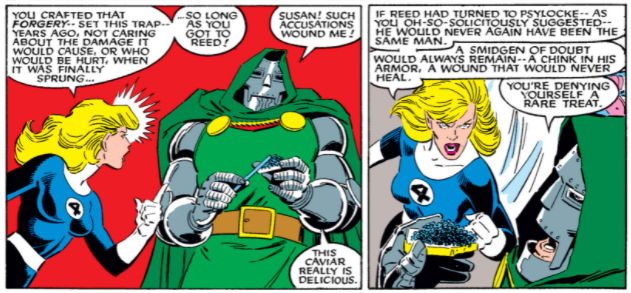 Sue warns Doom that she could kill him any time she wants using her forcefield, and when he doubts this she replies "Be careful Victor. A lionness is most dangerous defending mate and club and den." It's pretty awful dialogue, but it does lead to a nice image of Doom looking rather deflated.
Sue warns Doom that she could kill him any time she wants using her forcefield, and when he doubts this she replies "Be careful Victor. A lionness is most dangerous defending mate and club and den." It's pretty awful dialogue, but it does lead to a nice image of Doom looking rather deflated.
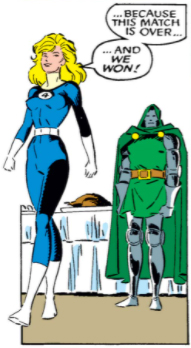 And there it all ends. This has been a rather peculiar series to read, especially when looking for signifiers of Doom. He's hardly in the first two issues at all, despite appearing on the (entirely misleading) covers, but when he does turn up he acts in a very Doom-like manner. Or maybe he just seems more suave, adult and intelligent when surrounded by a bunch of other characters who, apart from Franklin, are a load of hopeless idiots?
And there it all ends. This has been a rather peculiar series to read, especially when looking for signifiers of Doom. He's hardly in the first two issues at all, despite appearing on the (entirely misleading) covers, but when he does turn up he acts in a very Doom-like manner. Or maybe he just seems more suave, adult and intelligent when surrounded by a bunch of other characters who, apart from Franklin, are a load of hopeless idiots?
Talking of Franklin, we'll have a whole lot more of him soon, but before that we've got a few more cameos and posters to look at, as we very much head towards the last few texts in this whole thing! See you back here next time!
posted 6/8/2021 by MJ Hibbett
(click here for permanent link)
(0) comments